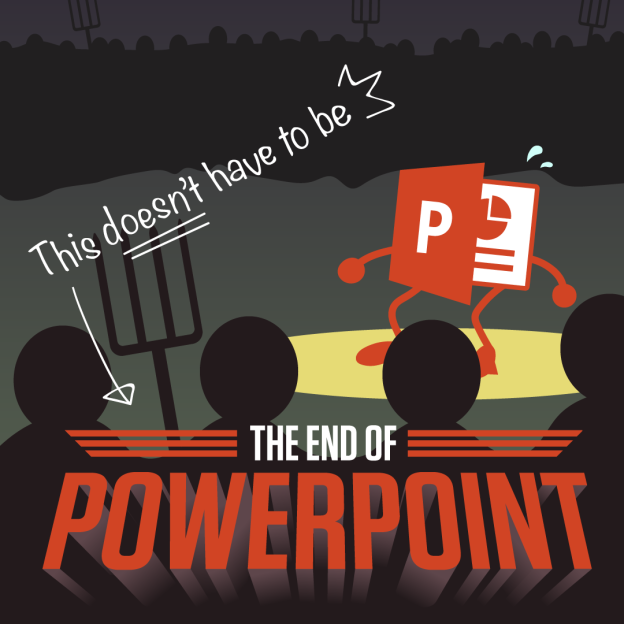This Doesn’t Have to be the “End of PowerPoint”
01.22.2016
Written By Anthony Gerstner, Training Manager at BDSmktg
There is a movement growing that seeks to put an end to PowerPoint. U.S. Generals have voiced their displeasure – one going so far as to ban it from his meetings. The CEOs of LinkedIn and Amazon have famously banned the use of PowerPoint in meetings at their respective organizations. Countless other leaders in both the private and public sector are voicing their displeasure and looking to eliminate PowerPoint wherever possible.
Let’s be clear, whether it’s PowerPoint, Keynote, Google Slides or any other presentation software – many of the arguments against their use are valid. After all, the term “death by PowerPoint” is well-known to anyone in the working world. Too often we are found wasting our time attending PowerPoint presentations that have nothing valuable to add, facilitated by a presenter that knows little beyond the bullet points on the slides.
So these leaders are right to see a problem and implement a solution that solves that problem for their teams. With these leaders being the influential people they are, many others are looking to emulate their practices. This has led to a general decree that the end of PowerPoint is near.
PowerPoint, however, is not the problem. It is how we have grown to use PowerPoint that is the central issue. Eliminating PowerPoint obviously solves the issue, but we could just as easily solve the problem by evolving the way we use PowerPoint for the better. Furthermore, PowerPoint came to be in such wide use because of the effectiveness in using visuals to demonstrate a point to an audience. PowerPoint isn’t going away. Even Jeff Bezos has to use slides when introducing the latest Amazon product – proving that if you know how to use PowerPoint effectively, there would be no need to call for its elimination.
So what must be done to improve the way we use PowerPoint? First, a presenter (and in my world, training instructors) should not use slides in a presentation as a place to put all of their written text. If you are going to have paragraphs on a slide, you may as well have brought a printed document for the attendees to read. Instead, make your slides visual to demonstrate your ideas and use minimal bullet points.
Going a step further, a presenter needs to be fully informed on the topic they are discussing. Too often, the speed of business means a speaker prepares very little for their presentation and is making up much of what they are saying on the spot. In eliminating PowerPoint, employees at Amazon and LinkedIn have to come to the meeting prepared and ready to answer any questions that may be raised at a meeting. Why should we expect less just because someone has a fancy presentation? Businesses should hold their employees accountable. Speakers should come to presentations prepared and ready to answer almost any question that results from the topic. The presentation will flow more smoothly because the presenter knows what they are talking about, and can keep things moving rather than having to constantly pause to determine how to respond or what to say.
Most individuals in businesses today have very limited time and almost never have a chance to review materials until they are in the meeting. There is no effective difference in having all stakeholders sit and read a six page memorandum for thirty minutes at the beginning of a meeting than it is to have a speaker run through a presentation for the same thirty minutes, provided the speaker is prepared and knowledgeable and the presentation has an impactful format.
In fact, I would argue the presentation was a more effective use of time because everyone was likely able to grasp the concept presented to them better. A good presentation will address all the main ways different people learn – auditory, visual, and kinesthetic. That’s why PowerPoint is used so widely – because the visuals can be used to support what the presenter is saying. When used in this way, no one will be talking about “death by PowerPoint.” Instead, they’ll be looking forward to the next meeting.
“Microsoft PowerPoint and other presentation applications are turning the corner in creating features that are more suitable for education, making it easier to create more engaging presentations and harder in creating dry and boring decks,” said Scot Maurath, Director of Learning Design at BDSmktg.
With people’s attention spans reducing dramatically, we are all challenged with shortening our stories and getting to the point quicker – while still maintaining a creative punch within the presentation. But, that creative punch is not built in the slides, but rather delivered by a well-organized and prepared facilitator.
Sources:
http://www.thewire.com/politics/2010/04/why-the-military-declared-war-on-powerpoint/24663/
http://www.nytimes.com/2010/04/27/world/27powerpoint.html?_r=0
http://www.businessinsider.com/jeff-bezos-email-against-powerpoint-presentations-2015-7
http://www.forbes.com/sites/carminegallo/2012/09/07/jeff-bezos-and-the-end-of-powerpoint-as-we-know-it/#2715e4857a0b7050bf645977
http://www.npr.org/sections/alltechconsidered/2014/03/16/288796805/physicists-generals-and-ceos-agree-ditch-the-powerpoint
https://www.ted.com/talks/david_grady_how_to_save_the_world_or_at_least_yourself_from_bad_meetings